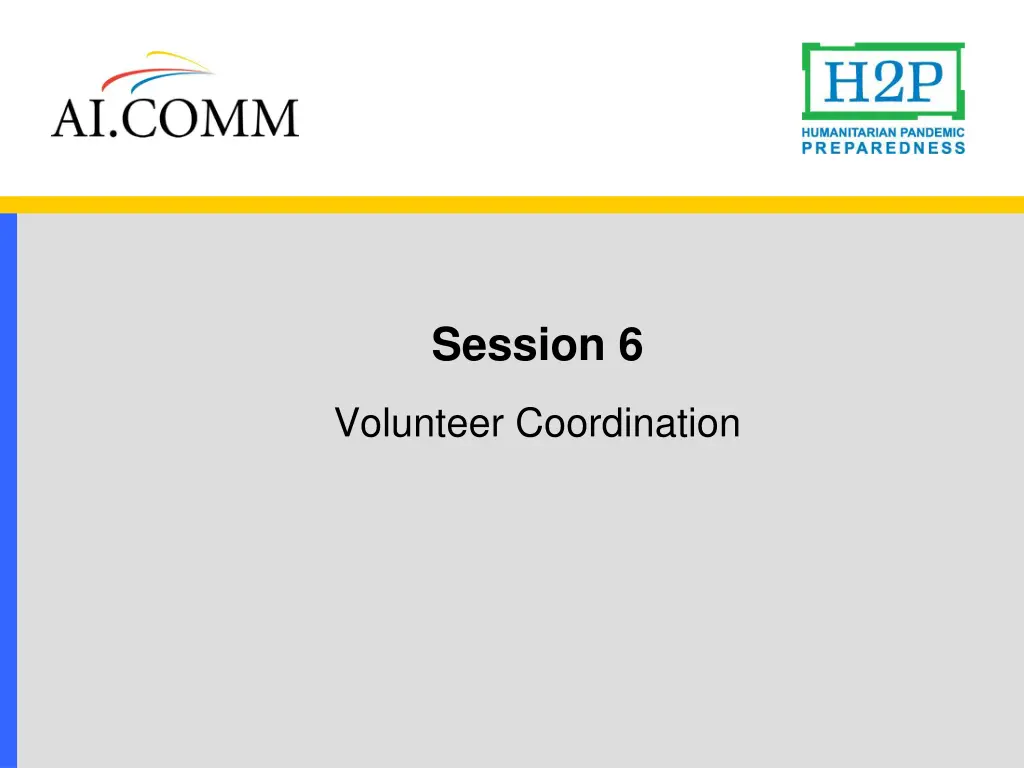
Community Volunteer Coordination for Pandemic Response
Enhance volunteer recruitment plans, identify volunteer roles, and raise awareness about community efforts to support food security during a pandemic. Develop an inventory of potential volunteer services and businesses, and identify excluded groups to ensure inclusive support.
Download Presentation

Please find below an Image/Link to download the presentation.
The content on the website is provided AS IS for your information and personal use only. It may not be sold, licensed, or shared on other websites without obtaining consent from the author. If you encounter any issues during the download, it is possible that the publisher has removed the file from their server.
You are allowed to download the files provided on this website for personal or commercial use, subject to the condition that they are used lawfully. All files are the property of their respective owners.
The content on the website is provided AS IS for your information and personal use only. It may not be sold, licensed, or shared on other websites without obtaining consent from the author.
E N D
Presentation Transcript
Session 6 Volunteer Coordination
The tool Volunteer Coordination will help response leaders: enhance existing plans for recruiting community volunteers identify possible volunteer roles and responsibilities that will help to protect food security during a pandemic Share information with households about critical role they play in supporting community efforts to ease the impact of a pandemic
Todays Objectives To raise awareness about how community volunteer efforts can fill gaps if a community s workforce is overwhelmed by the effects of a pandemic. To develop a sample inventory of groups and businesses that might be able to offer services in preparation for and during a pandemic.
3 types of volunteer support Services offered by local organizations and private businesses Volunteer man-power Personal resources.
Step 1: Identify potential volunteer services Gather leaders of community organizations and businesses Conduct an inventory of services each group currently offers to local communities services that they might be able to offer in preparation for a pandemic and during response additional training or resources needed to provide these services
Inventory of Community Services and Businesses Organi- zation Services currently offered Possible services to help prepare for a pandemic Possible services during a pandemic Resources/ training needed from the response team Supplies to reproduce education messages. Classes and flyers to spread public prevention education messages Adult education and computer training center Communication center ABC Help households to calculate the amount of food they will need to store for 12 weeks Training on key food security and health messages Reduce fear & panic Surveillance of illness Grief counseling Distribution of food /cash transfers Identification of poor households Household preparedness education Conflict management training for households Social support Training for food /cash management and distribution Church group Mobilize support for the poor
Step 2: Identify groups excluded from services Carefully consider each identified service Who might be excluded from accessing these services? For each excluded group, hold focus group discussions to determine how volunteers can provide better access to the services they will offer before, during, and after a pandemic.
Step 3: Recruit Lead Volunteers Call a gathering of representatives from various organizations and private businesses in the community. Business associations Local merchants and traders Community-based and religious organizations School teachers Women s groups Youth groups Municipal government agencies Humanitarian and development nongovernmental organizations Health centers and hospitals Ranch or farmer associations Local media Entertainers
Step 3: Recruit Lead Volunteers From each organization, identify one lead volunteer and two backup alternates Make sure to get contact information Make sure all volunteers are coordinated with health leaders and are up to date on safety measures re: spread of the disease
Step 3: Recruit lead community volunteers Identify roles and responsibilities If training is needed, identify the person from the response team that will provide the training Managing food inventories Public service maintenance Risk communication
Step 4: Recruit Volunteer Teams Many volunteer activities are not complicated nor do they need to involve expertise. Create awareness about the need for volunteers at public meetings Brainstorm with meeting attendees about how each person may be able to contribute Stress the importance of building a unified community that collectively and individually helps each other
Step 4: Recruit Volunteer Teams Establish volunteer recruitment centers Maintain an updated contact list that includes: Contact information- phone, home address, email address The responsibilities or resources the volunteer can offer with no training The responsibilities the volunteer is willing to carry out if they receive training
Step 4: Recruit Volunteer Teams Stay in close contact with the lead volunteers to determine the following: What type of help is most needed in each response area? How many volunteers are needed? How soon is their help needed? Do volunteers need any specific training before they begin to help?
What type of volunteers are most needed ? Retired healthcare personnel or people with medical training People who have recovered from the influenza strain Skilled laborers to help with the continuity of government services / construction of food storage spaces Mental health and spiritual People with disaster response training Remember ! Protect the health of your volunteers !!!
Volunteer activities to preparefor a pandemic: Alert area leaders of households that may be at high risk to food insecurity during a pandemic Help take an inventory of private food storage spaces Spread awareness messages Help households construct food storage facilities. Transport donated supplies from other regions Gather donations of narrow mouthed covered containers to donate to households that may not have adequate means for storing water
Volunteer activities once the pandemic reaches your community: Become a barter coordinator. Deliver fuel and water Help area leader manage neighborhood surveillance and documentation Connect people with health training to households with sick members Help organize at-home school activities for children Help distribute essential pandemic supplies Transport dead bodies
